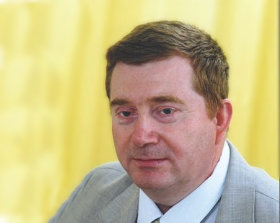Professor Kosakovskyi, a leading authority on Light Therapy.
THE inflammatory response is observed in many diseases. This response to tissue injury is a complex of vascular-tissue changes whose function is to limit the damage area and remove (or prevent the spread of) a pathogenic agent. The anti-inflammatory action of polychromatic and monochromatic polarized BIOPTRON-light has two phases. In the first (promoting inflammation) phase, the process of formation of reactive oxygen species on the cell membranes is stimulated, the release of cytokines (IL-1, IL-6, IL-8, TNF-α), which promote inflammation, is observed and peroxidation is enhanced. The vessel wall is damaged, platelet aggregation is inhibited, and the parietal assembly of cell elements occurs. However, the antioxidant protection is also activated at the same time, which to some extent suppresses the damage processes.
Local vasodilation takes place and arterial hyperaemia is stimulated under the influence of the subsequent sessions using BIOPTRON-light. The content of angiogenesis (vascular endothelial) growth factor (VEGF) is increased, and the migration of endothelial and stem cells is stimulated. The growth of micro-vessels and increased microcirculation lead to improved oxygenation of stagnant areas in the focus of inflammation and to the elimination of breakdown products. After this the polarised light stimulates the final phase of inflammation, proliferation (reparative regeneration) and self-limitation of the process. This increases the production of anti-inflammatory hormones, anti-inflammatory cytokine IL-10, which transforms the TGF-β growth factor. The chaperon (HSP-70 proteins) content, the "repair" proteins that restore the spatial structure of a protein molecule, is increased in the wound. This stimulates the division of many cell types (fibroblasts, monocytes, lymphocytes, endothelial and stem cells, thymocytes, myocytes, chondrocytes, keratinocytes, osteoblasts, and others.). The components of the respiratory chain (cytochrome-c-oxidase, flavoproteins, and adenine nucleotides) are activated; the content of adenosine triphosphaten mitochondria is increased. The regeneration of peripheral nerves, receptors and synapses is stimulated which prevents the development of neurogenic dystrophy. The volume of the focus of inflammation decreases gradually from the periphery to the centre, destroyed tissue is replaced by newly formed analogues or scar tissue.
Thus polarized light stimulates the triggering mechanisms of the inflammatory response and restricts it in later phases when restoring the structure and function of the damaged tissue by optimising the inflammatory response. In some cases, BIOPTRON-light, which causes significant recovery processes including for wound injuries, can be considered as a means of monotherapy.
Clinical observations conducted by the National Kyiv and Kharkiv Medical Academies of Postgraduate Education of the Ministry of Health of Ukraine, by Kiev and Odessa State Medical Universities of the Ministry of Health of Ukraine and by the leading medical institutions of Ukraine, have revealed the effectiveness of BIOPTRON-light for the treatment of diseases with associated inflammation, pain, immunodeficiency, spastic, swelling, neurotic, poly-traumatic and wound syndromes.
Among the large array of publications on the BIOPTRON-light therapy, research dissertations are considered to carry the most weight. An author has to perform the research in accordance with the prescribed rules of procedure, to publish the results in top-rated journals, to pass through the sieve of multi-stage review and to publicly defend the fundamental provisions. The topics of research dissertations containing sections on BIOPTRON-light therapy are given below:
- Chronic inflammation of supramaxillary cavities due to the effects of radiation exposure;
- Immune status in bronchial asthma combined with chronic fatigue syndrome;
- Respiratory disorders in children with the consequences of radiation exposure;
- Adaptive disorders in children (including acute respiratory viral diseases);
- Prevention and treatment of wound infections in obstetrics;
- Surgical purulent-septic complications in drug abuse and AIDS cases;
- Chronic posttraumatic osteomyelitis of the long bones of the limbs;
- Experimental graduated burn injury and monotherapy with BIOPTRON-light;
- Bronchial asthma and expired breath condensate indicators in background immunotherapy;
- Bronchial asthma and complications in the upper airways in background immunotherapy;
- Generalised periodontitis with cryodestruction;
- Zona serpiginosa (herpes zoster);
- Reproductive function in patients with endometriosis genitalis;
- Discirculatory encephalopathy and haemostasis markers;
- Neuro-humoral mechanisms of the systemic effects of physical factors of electromagnetic origin (including prostate diseases);
- Vegetative-vascular and neurotic disorders in transport drivers;
- Hypogalactia in women with anaemia of pregnancy;
- Ectopia of uterine cervix in nulliparous women;
- Vasoregulatory, haemodynamic, and immune disorders in cases of chronic glomerulonephritis.
